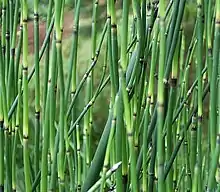Equisetum giganteum
Equisetum giganteum, with the common name southern giant horsetail, is a species of horsetail native to South America and Central America, from central Chile east to Brazil and north to southern Mexico.
| Equisetum giganteum | |
|---|---|
 | |
| Scientific classification | |
| Kingdom: | Plantae |
| Clade: | Tracheophytes |
| Division: | Polypodiophyta |
| Class: | Polypodiopsida |
| Subclass: | Equisetidae |
| Order: | Equisetales |
| Family: | Equisetaceae |
| Genus: | Equisetum |
| Subgenus: | E. subg. Hippochaete |
| Species: | E. giganteum |
| Binomial name | |
| Equisetum giganteum | |
| Synonyms[2] | |
| |
Description
It is one of the largest horsetails, growing 2–5 metres (6.6–16.4 ft) tall, exceeded only by the closely allied Equisetum myriochaetum (up to 8 metres (26 ft) relying on surrounding plants' support. One forma or variety has reached a height of thirtysix feet (eleven meters) in Venezuela,[3] and a height of 39 feet (twelve meters) in the Pantanal region of Brazil.[4] The stems are the stoutest of any horsetail, 1–2 cm diameter (up to 3.5 cm (1.33 inches) in diameter in some populations),[5] and bear numerous whorls of very slender branches; these branches are not further branched, but some terminate in spore cones. Unlike some other horsetails, it does not have separate photosynthetic sterile and non-photosynthetic spore-bearing stems.
Populations from northern Chile with very stout stems up to 3.5 cm diameter have sometimes been treated as a separate species Equisetum xylochaetum,[6] but this is not widely regarded as distinct. The thickest specimen to be reported by a trained botanist is 1.57 inches (four centimeters) by Dr. Thomas Schoepke on the Lluta River near Arica, Chile circa 1999-2000.[7][8]
References
- Christenhusz, M. (2019). "Equisetum giganteum". IUCN Red List of Threatened Species. 2019: e.T156392750A83689185. doi:10.2305/IUCN.UK.2019-3.RLTS.T156392750A83689185.en. Retrieved 20 December 2022.
- Tropicos.org, retrieved 5 January 2016
- Botting-Hemsley, W. (1888). Biologica Centrali-Americana - Botany - Volume 3. London: R.H. Porter and DuLau & Co. p. 699.
- Decker, Joao S. (1936). Aspectos Biologicos da Flora Brasileira. Sao Leopoldo, Brazil: Rottermund & Co. p. 538.
- Husby, Chad. "How large Can Giant Equisetum Become?". Retrieved August 25, 2004.
- Equisetum xylochaetum at Flora Brasiliensis online
- Correspondence with Equisetum specialist Chad Husby of Florida international University.
- Husby, Chad (n.d.). Equisetum/HoeLarge.html "How Large can Giant Equisetum Become?". Retrieved August 25, 2004.
{{cite web}}: Check|url=value (help)
External links
 Media related to Equisetum giganteum at Wikimedia Commons
Media related to Equisetum giganteum at Wikimedia Commons- fiu.edu: Giant Horsetails
- (in Portuguese) Lorenzi, H. & Souza, M. S. (2001). Plantas Ornamentais no Brasil: arbustivas, herbáceas e trepadeiras. Online ISBN 85-86714-12-7
